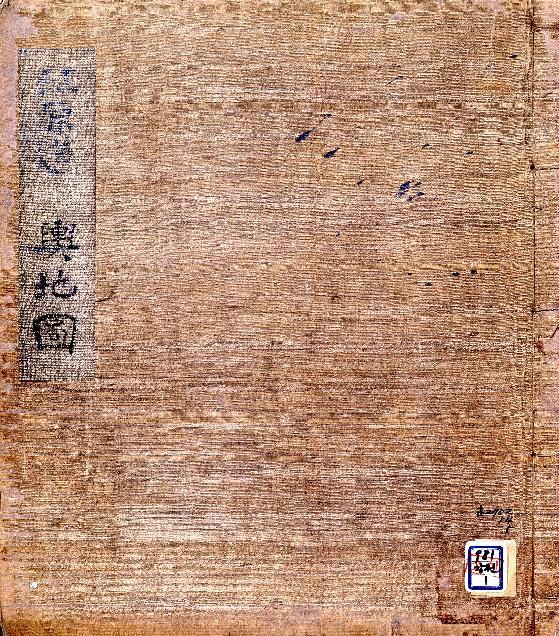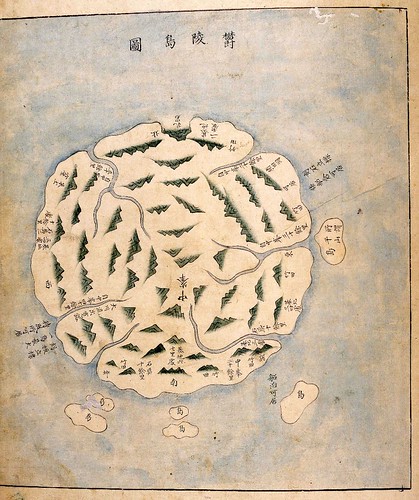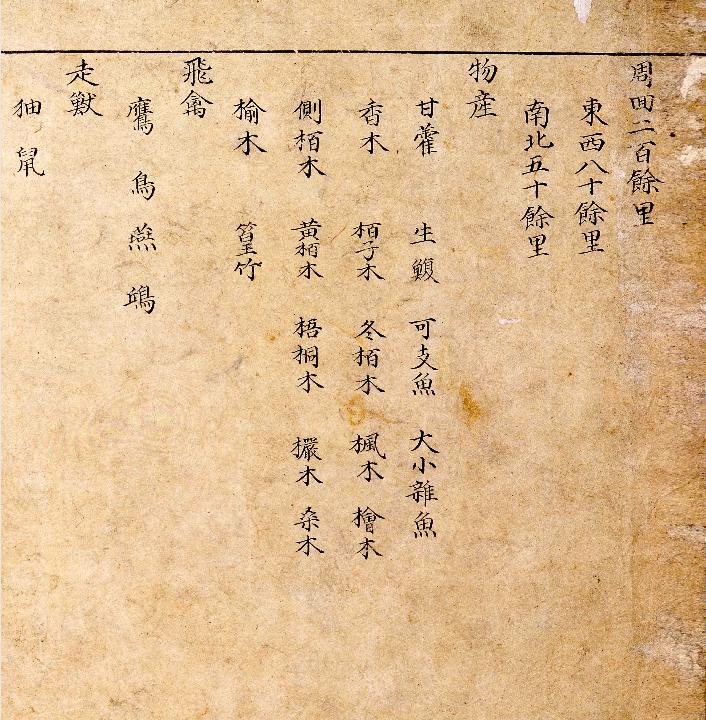 The map below is of the Korean island of Ulleungdo (鬱陵島). It comes from the atlas "Paldo Yeojido" (八道輿地圖), which is believed to have been made sometime in the mid 1700s. The atlas said that Ulleungdo had a circumference of bout 200 ri (80 kilometers), and measured about eighty ri (32 km)from east to west, and about fifty ri from north to south (20 km). The atlas also lists some of the flora and fauna found on the island at the time, which included "sea lions" (可支魚). The map below can be found in the Gangwon Province (江原道) section of the atlas (江原道 輿地圖), the cover of which is pictured on the left. The map and atlas are stored in the National Library of Korea.
The map below is of the Korean island of Ulleungdo (鬱陵島). It comes from the atlas "Paldo Yeojido" (八道輿地圖), which is believed to have been made sometime in the mid 1700s. The atlas said that Ulleungdo had a circumference of bout 200 ri (80 kilometers), and measured about eighty ri (32 km)from east to west, and about fifty ri from north to south (20 km). The atlas also lists some of the flora and fauna found on the island at the time, which included "sea lions" (可支魚). The map below can be found in the Gangwon Province (江原道) section of the atlas (江原道 輿地圖), the cover of which is pictured on the left. The map and atlas are stored in the National Library of Korea.The mapmaker drew Ulleungdo in a circular shape, which was a common way to draw the island at that time. A small island was also drawn off the east shore of Ulleungdo and labeled as "所謂 干山島." That translates as "the so-called Gansando," which was almost certainly a misspelling of Usando (于山島). Korea claims that Usando was the old Korean name for "Dokdo" (Liancourt Rocks), but this map of Ulleungdo and many others show that Usando was just a neighboring island of Ulleungdo. In fact, there are no Korean or Japanese maps that show Usando as Liancourt Rocks (Dokdo).
The map also shows five small islands off the southern shore of Ulleungdo, which may have been a mapping errors since many, but not all, of Ulleungdo's neighboring rock islets (石島) are off its nortern shore. At any rate, the map shows Ulleungdo with six, small neighboring islands, of which Usando is the most prominent.



This comment has been removed by the author.
ReplyDeleteNotice that the list of animals on the island included a Chinese character for a kind of "monkey," which is a character my computer is unable to show. Anyway, I do not think there were monkeys on Ulluengdo, but there were reportedly cats (猫), whose Chinese character looks similar to the one for monkey.
ReplyDeleteIn a 1786 survey report on Ulleungdo, the same "monkey" character was also used to describe one of the animals on the island. Is it possible that the mapmaker saw 1786 report and made the same mistake, which would mean the map came after the report. I wonder why this map is believed to have been made in the mid 1700s instead of the late 1700s?
Here is the report of the Ulleungdo survey from Korea's "Ilseongrok" (日省錄). The place where the character is suppose to be in the report shows up as "㹨", but if you look up the record on Seoul National University's Kyujanggak Web site, you can see the character there.
原春監司 李致中狀啓鬱陵島搜討乙巳年爲次第而因嶺東慘歉前監司 徐鼎修狀聞停止今年搜討官當次越松萬戶 金昌胤牒呈內四月十九日候風于平海丘尾津二十七日午時分四船與倭學李裕文上下員役沙格竝八十名齊發二十八日卯時船格等指曰彼黑雲底乃島中上峯云云未過數時最高三峯宛然入望四更未四船同聚悲喜交極各陳危怖之狀二十九日解纜到苧田洞四船之人沐浴山祭後看審則自洞口至中峯二十餘里重峯疊嶂內外相連中有三峯最秀此是一島之主鎭而洞裏石城痕周可數三里宛然猶存城內有大錐巖小錐巖石礎苧田等處土地平衍可墾田畓八九石落前進可支仇味則山腰有兩石窟其深難測可支魚驚出投水之際砲手齊放捉得二首五月初一日卯時轉向南邊倭船滄則自洞口至中峯三十餘里皆是殘山石城石塔石葬等遺址宛然轉向前面巖壁削列水邊到長作地竹林處則竹林稀疏元無體大者北到天磨仇味初二日平明省審則有巖屹立水中狀如牛角名以帿竹巖束有防牌島距大島爲三里許初三日到玄作地石山重疊海邊則嚴石而已錐山則山形奇異石色怪黑竹巖則兩巖屹立狀如帿竹傍有孔巖中通小桶船到黃土 仇味則山形重疊谷水成川可畓三十餘石可田數十餘石自洞至中峯三十餘里左右土窟巖石上有前日搜討官等題名初四日轉向香木亭大抵一島周回可百二十餘里南北七八十里東西六七十里四面皆絕壁山形箇箇峻險大溪小澗或瀑或流千丈銀虹萬斗噴玉自待風所望見樹木則冬栢側栢香木楓木檜木欕木梧桐桑楡檀木羽蟲則島鷗毛族則㹨鼠而已海族則甘藿 鰒魚 可支魚搜探後同日申時一行齊登壇上謹祭海神掛帆旋歸初五日酉時萬戶船還泊三陟遠德面長五里戌時倭學船二隻來泊亥時下卜船一隻又來初七轉泊待風所初八還鎭所產可支魚皮二令靑竹三箇紫檀香二吐莫石間朱五升本島圖形一件牒呈上送備邊司緣由馳啓
Mr Gerry,
ReplyDeleteI don't know what is "㹨"
I guess it under the discription,㹨鼠 is Waesel(鼬鼠いたち類),not 㹨 and 鼠mouse. 鼬's shape also similar with cats.
I heard its far use for Ink brush筆 or cloths. I think mouse鼠 is everywhere and not special local products.I don't know Korean at that time eat mouse.
Tsusima対馬,Japan and Korea,some Waesel(Itati) lives there today.
GTOMR,
ReplyDeleteWhen these reports talk about 鼠, I wonder if they were actually referring to squirrels, which is written as 栗鼠 in Chinese characters? Also, maybe the so-called monkeys they saw were actually squirrels? However, honestly, I do not think there were squirrels or monkeys on the island. I think there were just rats and cats.
Rats can get anywhere because they can hide on ships going to the island, and the cats were probably taken there by early settlers to keep the rat population under control since the rats would not have had any other natural enemies. Anyway, most of these reports said there were rats and cats on the island, and that is probably exactly what they were.
GTOMR,
ReplyDeleteI was wrong to say that the rats would not have had any other natural enemies on the island since there are some birds that like to eat rats. In fact, the map says there were hawks (鷹) on the island, and hawks think rats are a nice meal.
Oh,sorry on the photo bottow to introduce local products you posted,they clearly separate 㹨 and 鼠 on the introduction of running animals走獣.
ReplyDeleteSO I guess there are 㹨=kind of Waesel鼬,and mouse鼠.
I forgot which articles, but there are some record that mouse are fat like cat on Ulluengdo.If so it is special.鼠如大猫
GTOMR,
ReplyDeleteI still think the character was supposed to be 猫 (cat), but he just miswrote it. Notice that the guy miswrote other Chinese characters, as well. Here are a few examples:
燕 - swallow
鳩 - pigeon
走獸 - creeping animals
鼠 - rat
According to Ahn Yong-bok's statement during the investigation (肅宗實録), he told about Ulleungdo:
ReplyDelete山多雜木、鷹烏猫倭船亦多來泊
There are lots of various woods, hawks, craws, cats in (Ulleungdo's) mountains and Japanese ships...
And although it is not Ulleungdo, there are "wild cats" in Tsushima (Tsushima yamaneko對馬山猫), an endangered species.
Mr.Gerry and Pacidist-san,
ReplyDeleteYes, 㹨 could be cat猫 that you suggested.And 猫 is promonent animals each record on Ulleungdo.